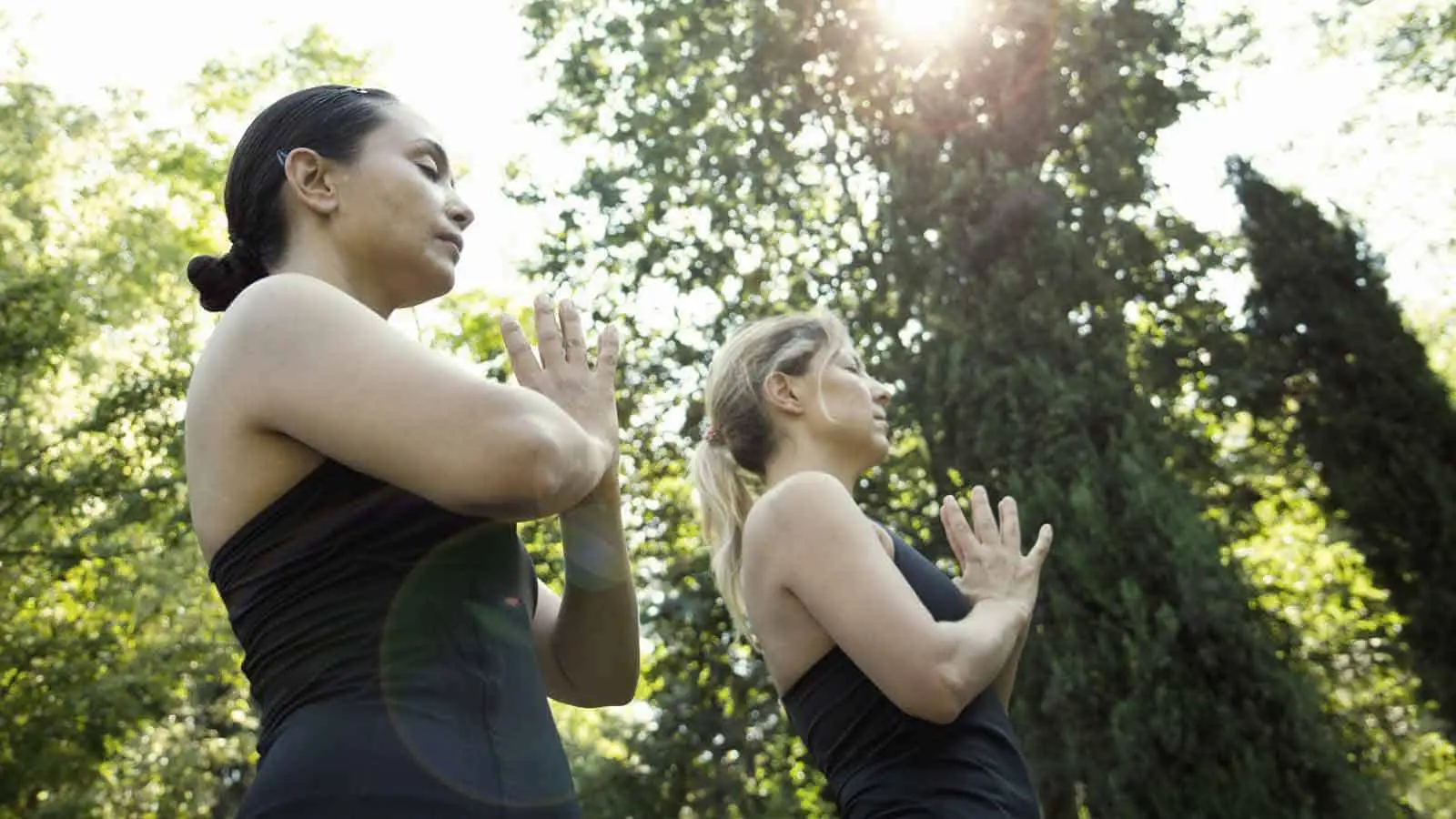Outside yoga is an excellent way to get in harmony with nature while doing some exercise. Yoga in the outdoors can be done in a variety of settings. The addition of nature to your yoga routine fuels your mind-body-spirit connection, which is essential in any yoga practice.
Yoga can be done on the grass. It is best to seek out lush, flat grass for outdoor yoga, and you can use a blanket or yoga mat for comfort when needed. Nature is the perfect environment for any yoga practice because it provides a deep connection to the energy flowing through the Earth’s surface and the yogi.
In this article, you will learn everything you need to know about outdoor yoga. Doing yoga in nature provides a strong spiritual connection, unlike any connection found in a yoga studio. This connection is what drives many yogis to prefer the outdoor setting. Read on to discover just how connected to nature you can become during a simple practice!
Yoga in the Outdoors
Doing yoga outside is a fantastic way to change up your practice, especially if you are a little tired of the indoor environment. Outdoor yoga is a great way to reconnect with nature. Nature provides a new source of energy to draw on during your practice. Yoga in the grass brings you closer to your center and grounds you with the Earth’s energy.
Here are some of the benefits you gain by practicing yoga in the grass:
- Spending time outside makes you healthier
- Feeling Earth’s energy strengthens your connection to the spirit
- Incorporating natural sensations deepens your mind-body connection
The Outdoors and Your Health
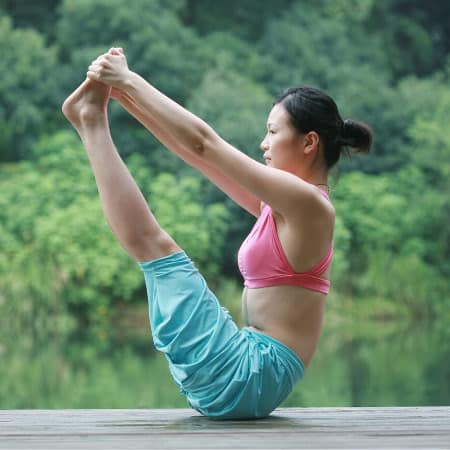
Doing yoga outside combines the benefits of a simple yoga practice with the benefits of spending time outdoors. This is a significant reason to consider bringing your routine into an outdoor space. Being outside adds to the already plentiful benefits of yoga.
Some of the benefits of doing yoga in the outdoors include:
- Provides natural de-stressing
- Increases vitamin D
- May reduce inflammation
- Resets your internal clock
- Increases self-esteem
- Improves mood
- May lower blood pressure
- Improves concentration
Earth’s Energy as a Source of Strength
The ground you walk on is constantly emitting electrons. These are a form of energy that you can draw from while doing yoga outside.
These electrons can provide some fantastic benefits to the body:
- Decreases pain
- Positively influences sleep habits
- Balances hormone levels
The Mind-Body-Spirit Connection
The mind-body-spirit connection refers to the connection of your thoughts, your physical health and well-being, and how you see yourself. The mind-body-spirit connection is not always explicitly mentioned in yoga practices, but you may have sensed it before without knowing.
How does yoga lead to a stronger mind-body-spirit connection?
- It helps you draw from your senses – When doing yoga, you can better listen to the sounds around you and take in your surroundings.
- It encourages grounding – Using the Earth as an extension of your energy, you can bring the energy up from the soil through the crown of your head to promote grounding.
- It provides consistent energy check-ins – Body scans and deep breathing allow you to focus on what is happening in your mind and body.
Since yoga uses nature as its inspiration (think crow pose, mountain pose, and tree pose), tapping into the mind-body-spirit connection while doing yoga in the grass can be very harmonious. Because you are focusing on all parts of your being – mental, physical, and spiritual – you develop a deeper sense of self and connection to the world around you.
Why Do Yoga Outside?
There are many reasons to do yoga in the outdoors. You should consider doing yoga outside because it brings you closer to nature, which can be very centering. The focus you gain from practicing yoga in the outdoors is only one of the wonderful benefits. However, moving your yoga practice to the outdoors does come with a few pros and cons.
The following chart outlines some of the pros and cons of yoga in the grass:
Pros
- Connection with nature
- Feeling grounded to Earth
- Can make poses more challenging depending on terrain
- Fresh air
- Dual de-stressing – yoga, and nature both decrease stress levels
Cons
- Insects
- Weather can be unpredictable or uncomfortable
- The ground may be too uneven or uncomfortable
- Can be distracted easily if in a high traffic area
Where to Do Yoga Outside
Honestly, you can do yoga anywhere in the outdoors that you would like. This means the world is your yoga studio! All you need is a flat surface. Depending on the surface type, you may or may not prefer a yoga mat or blanket to protect your hands, knees, and feet. Many times, yogis prefer a yoga mat to stay relaxed throughout their entire routine.
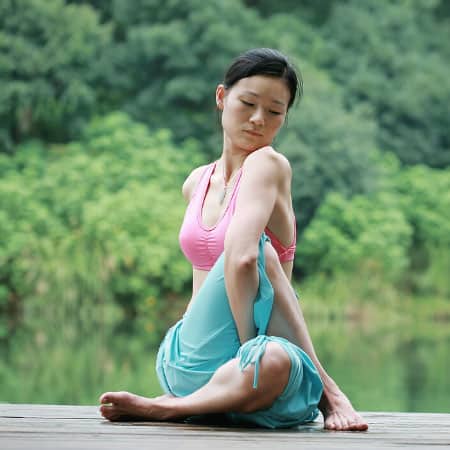
You will need the following items to do outdoor yoga:
- Yoga mat or blanket (optional)
- Water bottle
- Sunscreen
- Bug repellent (optional)
- Hat or shady area (optional)
- Towel (optional)
A field or grassy area is a perfect setting for beginners doing yoga in the outdoors. These areas generally provide a softer landing for any falls than other types of terrain.
Here are a couple of places to try yoga on the grass:
- At your local park
- In your backyard
Water is a very calming backdrop for a yoga practice. The sound of ripples, waves, or croaking frogs can be very soothing during your yoga practice. Find a grassy knoll near the water and breathe deep!
Try yoga by the water in the following locations:
- Riverside
- Lakeside
- At the Beach
How to Choose the Outdoor Space Right for Your Yoga Practice
Doing outdoor yoga means you can go pretty much anywhere, lay down your yoga mat, and begin your practice. However, it is a good idea to be a little more selective when identifying a space to practice yoga outside. There are a few considerations to make when choosing an outdoor space.
The following points are features to look for in an outdoor yoga space:
- A flat surface to avoid any unnecessary injuries
- A quiet, peaceful environment to avoid distractions
- Enough open area to fall and stretch safely
- A comfortable surface, especially if you opt for no mat
- A safe space
- Out of the way of regular foot traffic
Where Do I Start If I Want to Do Outdoor Yoga?
Getting started with yoga in the outdoors can be pretty simple. Today, your mobile device can connect to the internet anywhere, so you can even watch a yoga video or listen to binaural beats while out in nature. However, if you need to log off and disconnect from your devices to focus, it is only a matter of finding a class to take or doing a self-guided session.
Talk with Your Local Studio
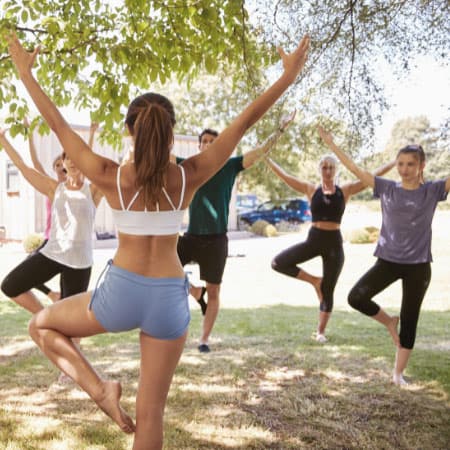
Local studios often hold outdoor yoga sessions if there is enough interest. A local studio will have a trained yoga teacher leading the session. They may even provide yoga mats, blocks, blankets, and more, depending on how close the studio is to the outdoor space.
These are a few of the perks of doing yoga outdoors with your local studio:
- Trained yoga teacher
- May provide certain equipment
- Quiet, flat space dedicated to yoga
Aside from the perks, there are some downsides of yoga outdoors with your local studio:
- More costly
- It can feel too crowded
Check with Your Local Parks Organization
Local parks sometimes sponsor “yoga in the park” events. These are a great way to check out the local parks system and meet people in the area.
The following are the perks of doing outdoor yoga with a park organization sponsor:
- Dedicated park space for yoga
- Generally, very flat
- Mostly quiet
- Great way to meet people in your local community
- Can be open and sunny or wooded and shady
- Sometimes free or minimal cost
There are some downsides of doing outside yoga with a park organization sponsor, too, such as:
- It can be quite crowded, especially free classes
- Space is not solely dedicated to yoga
- May have more passersby, especially in a high traffic park
Look on Social Media for Outdoor Yoga Classes
There are free outdoor yoga events advertised frequently on social media. Some studios and park systems use social media to promote their yoga events. Some social platforms even have dedicated “yoga in the park” or “yoga in the outdoors” groups.
Lead Your Own Yoga Session Outdoors
Taking your mat into the woods or on the beach may seem a little daunting at first. However, if you are comfortable with a self-guided flow, this may be an excellent option for you.
The following are some perks of doing yoga outside by yourself:
- Calm and peaceful
- Stay as long as you want
- Do as little or as much as you want
- Direction is entirely up to you
Yoga in the grass by yourself has a few disadvantages, also, like:
- No cues to follow
- May lose track of time
- May be hard to stay focused in nature with distractions
What type of flow should you follow when you are doing outdoor yoga?:
- Follow a simple flow when you are first starting.
- Any directed movement in the outdoors can constitute a flow.
- Do a comfortable flow you are familiar with
- Incorporate a more extended meditation.
These are just a few options to get you started with outdoor yoga. All three options are good selections for any level of yogi. If you are looking for a specific yoga level, such as beginner or advanced, you can also seek out those classes and events.
When to Do Yoga in the Outdoors
You can do yoga outside at any time of day, but there are some perks to choosing specific times. Mainly, many people draw on a strong spiritual connection when choosing a time of day to practice yoga. The Moon and Sun have very different energies, which can influence when you decide to do your routine.
In the following chart, you will learn what time of day is best to practice yoga in the outdoors:
Before Dawn
PROS
- Usually cooler, depending on your region
- Sunrise practices are beautiful
- An early start means you can check yoga off your list first thing
- New Moon yoga before dawn provides a fresh start
CONS
- Can be very dark, depending on the time of year
- May require a headlight
- May come across more wildlife
- More insects
Early Morning
PROS
- Usually cooler, depending on your region
- Sun is up but not too hot or bright
- The sun energizes you for the rest of the day
CONS
- Usually, birds are very chirpy
- The grass is wet with dew
- Damp soil
Afternoon
PROS
- May be good for hot yoga routines
- May be quieter in terms of wildlife and people
- Fewer distractions
- Dry ground
- The sun is generally dimmer and exudes a calmer energy
CONS
- Generally, much hotter than early morning
- Full sun
- Most likely will want to find shade
- Risk of sunburn
Evening or Dusk
PROS
- Sunset yoga is amazing; its energy is very restorative after a stressful day
- Generally cooler at night
- No need to worry about finding shade
- Full Moon provides a deep connection to both sun and moon energies
CONS
- Lower visibility as the sun goes down
- More likely to encounter bugs
- More likely to come across nocturnal wildlife
Even though this chart compares picking a time based on the weather and outdoor environment, you should also consider a few other things when choosing a time for your outdoor yoga practice.
When picking a time for your outdoor yoga practice, you should also consider the following:
- What time works best with your schedule?
- When do you feel most energized?
- What time matches the flow you are aiming for?
Choose a time that works best for you and your practice to get the most out of outside yoga.
Is A Certain Skill Level Required to Do Yoga in The Outdoors?
To do yoga in the outdoors, you can be any level of yogi; you do not need to be an expert. A beginner’s outdoor class can be inspiring for the new yogi. Below are things to consider based on all skill levels.
Some tips when trying yoga in the grass are:
- Bring a comfortable mat or skip the mat for a more intense session.
- Do not be afraid to relax into a child’s pose.
- Take water breaks as needed.
- Remember that any pose can be modified.
- If you have concerns, discuss them with your teacher before or after class.
As you develop your yoga practice, you will become more confident and comfortable with changing your flow. Even an expert can find the challenge in an outdoor class aimed at beginners. Yoga is all about listening to your body and modifying the poses to your skill level.
What to Wear for Outdoor Yoga
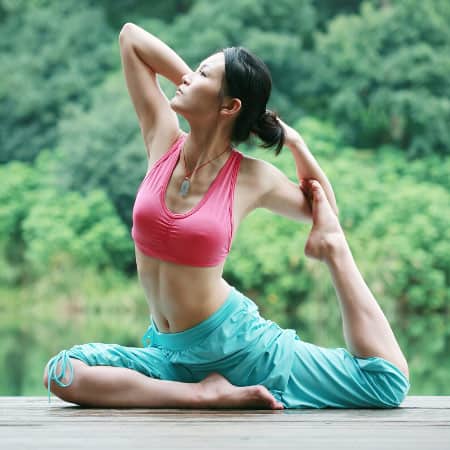
Figuring out what to wear for outside yoga can be challenging. Finding an outfit that you are comfortable in that makes you feel empowered during your outdoor practice is essential. The key to a successful yoga practice in any condition is comfort.
When doing yoga in the outdoors, you should wear clothing that best fits your style and the weather:
- Comfortable pants or shorts, depending on the temperature
- A hoodie to put on if you get cold
- Moisture-wicking fabrics for hot days
- Clothing that moves with your body
The Importance of Water in An Outside Yoga Practice
Water is an important part of any exercise regimen. When you are yoga outside, you must consider the elements and how they impact your practice. Water is one of the most essential parts of any exercise routine.
Why is water important to your outdoor yoga practice?
- It is required to stay hydrated.
- It helps with focus.
- It improves muscle health.
- It increases joint flexibility and lubrication.
How to Reduce Distractions When Doing Yoga Outside
Distractions in an outdoor yoga practice can be very inconvenient. You should always aim for a calm and quiet yoga practice; however, many things can lead to annoying or bothersome distractions when doing yoga outside.
The following are some tips for reducing distractions while doing yoga in the outdoors:
- Choose a low-traffic area – You may have to start earlier or later to miss any potential crowds.
- Pick a spot away from busy paths – Make sure you are not blocking any trail or path to avoid interruptions from passersby.
- Look for a flat and quiet location – If you like a babbling brook, set up near one. If you want a quieter spot, opt for a lakeside or forest locale.
- Wear headphones – Sometimes, nature itself can be a little noisy, and listening to a soft harmony playing can be centering.
- Skip strong scents – Wear bug repellent and skip your perfume to avoid any flying distractions.
- Spread out a blanket – Claim a larger area by spreading a large blanket and putting your yoga mat on top.
If you get distracted during your practice, try these tips to get back on track:
- Do not get mad at yourself.
- Take a deep breath.
- Notice that your mind wandered and bring your attention back to your center.
- Take a child’s pose to refocus, reground, and recenter yourself.
You cannot always avoid distractions, but you can learn how to adjust your thinking and quickly recenter your practice when they do happen.
Some Simple Flows for Yoga in the Outdoors
Since you may be feeling excited about yoga practice in the outdoors and ready to get started, below are a few simple flows you can follow.
Option One: A Repeating Flow
Flows are the basis for most vinyasa practices. You move through the poses at a relatively fast pace, resulting in great exercise.
Follow these five steps for a repeating outdoor yoga flow:
- Start in mountain pose. Ground yourself by spreading your toes. Hold your hands by your side and spread your fingers wide. Feel the energy moving up from the Earth, into your fingertips, and out through the crown of your head. Hold for 3 to 5 breaths.
- Slowly bend forward into a forward fold and plant your hands on the ground. Option: hold your elbows and sway side to side. Nod your head yes and no. Come to stillness. Hold for two breaths.
- Take your time getting into downward dog. Walk your hands out in front of you and pedal your feet. Find a movement that feels good. Come to stillness and hold for three to five breaths.
- From here, move through chaturanga into upward facing dog. Move with your breath.
- Move back into downward-facing dog. Once still, take two breaths.
- Repeat this flow as many times as desired. It is recommended to repeat it three to five times.
Since this flow is focused mainly on repeating core yoga poses, keep your focus on holding and feeling present in each pose. Notice how your body feels at each stage. Listen to your body; you can choose to hold a pose for longer or add another pose into the mix with each repeat.
Option Two: A Yin Practice
With yin yoga, you hold the poses for minutes at a time. This allows for deep stretching and relaxation. Yin yoga is a great practice to close your eyes and listen to your surroundings.
These fourteen simple steps will guide you through your yin outdoor yoga practice:
- Start in a seated position. Place your hands comfortably on your knees, thighs, or the mat. Close your eyes and find a comfortable breath.
- When you’re ready, lie down on your back with your legs extended and arms by your side. Bring your right leg up to your chest. Hug your leg for two to five breaths.
- Bring your right leg across your body and slowly twist into a number “4” shape. Have both your arms fully extended, like a “T,” or hold them in as cactus arms.
- Turn your head to the left and try to keep both shoulders on the ground. Hold for two minutes.
- Repeat on the left side.
- Extend both legs and shake them out.
- While still lying down, draw your legs up into Supta Baddha Konasana, or reclined cobbler’s pose. Hold for two minutes. During this time, don’t forget to focus on your breathing.
- From Supta Baddha Konasana, hug your knees into your chest and rock back and forth, side to side for a few breaths.
- Then, move into a happy baby pose. Send your heels up to the sky, bending your knees into your chest and opening them. Activate your smile muscles; it is a happy baby pose after all! Hold for two minutes.
- From here, slowly move into a table-top position. Take your time and move with your breath. Move through a few cat-cow poses and come to stillness.
- Send your right leg out in front of you. Then, sit back into a pigeon pose. Hold for five to ten breaths.
- Fold forward to lay your stomach on top of your right thigh. Bring your forehead to the ground. Keep your arms stretched in front of you, folded to support your forehead, or down by your sides. Hold for one to two minutes.
- Return to table-top position and repeat on the left side.
- Finish by lying on your back in a corpse pose with your legs outstretched and arms by your sides or on your stomach. Hold for five minutes or as long as desired.
Yin yoga is all about patience and focus. You may feel antsy in some of the longer poses. When this happens, recognize the feeling, but stay in the pose. Resist switching poses unless you are in pain.
Yoga is supposed to be challenging, but you should not experience any sharp, sudden pain or uncomfortable sensations. Whenever you feel pain or discomfort during yoga, adjust your movement or end your practice to let your body rest.
Important Considerations for Outdoor Yoga
There are many ways to enjoy outdoor yoga, but there are even more things to remember to ensure that your routine is as relaxing as possible.
When doing yoga in the grass, make sure that you:
- Are comfortable in your clothes and space
- Wear sunscreen to protect your skin
- Wear bug repellent to avoid buggy distractions
When you are outside, you will want to bring a mat for outdoor yoga in these situations:
- You are a beginner
- The terrain is rough on bare hands and feet
- You want a cushion in case of falls
- You want added stability
In the following scenarios, you will want to use a blanket during your yoga practice in the grass:
- You do not have a yoga mat
- You want a softer, cozier base
- You want a slight challenge
Try skipping the mat or blanket during outdoor yoga in the following circumstances:
- You are looking for a challenge
- You are on sand or another type of soft ground surface
Your yoga practice is your own, so customize it by incorporating your style. Find what feels great for your body. Don’t be afraid to try new flows, positions, and environments to find your perfect outside yoga experience.
In Conclusion
Yoga in the outdoors is a great opportunity to expand on your regular yoga practice. Yoga outside is an awesome option for yogis at all different levels of expertise. Outdoor practices offer many fun and new opportunities to connect with nature and the Earth’s energy.
If you have not considered doing yoga outside in the past, now is the time to try. Yoga focuses on the mind-body connection, and adding the feeling of the Earth under your feet makes the experience that much more powerful. You will find a new appreciation for your ability to focus and center.

